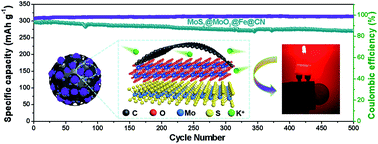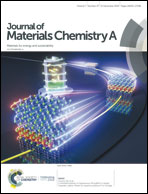Controlled building of mesoporous MoS2@MoO2-doped magnetic carbon sheets for superior potassium ion storage†
Abstract
Molybdenum disulfide (MoS2) has attracted considerable attention as a candidate for potassium ion storage. However, the MoS2 anode material is limited by its poor electron conductivity, poor structural stability due to large volume variation, growth of potassium dendrites and sluggish chemical kinetics. The combination of optimizing phase morphology, elemental composition, and surface nanostructure is effective for solving these problems. Herein, Fe was first encapsulated into the porous biomass-derived carbon during the Fe-catalysed post-annealing process. Subsequently, MoS2@MoO2 was well wrapped into the porous N-doped carbon matrix (CN) and the prepared MoS2@MoO2@Fe@CN was evaluated as an anode material for potassium ion batteries (KIBs). The growth mechanism of MoS2@MoO2@Fe@CN was thoroughly studied and the synthesis conditions were further explored. The good encapsulation of metallic Fe within the carbon framework and its intimate integration with the heterojunction of MoS2@MoO2 facilitate the transportation of electrons and ions, supplying favourable mass transfer. The low energy barrier for K+ insertion/extraction into the Mo–S–O and N–Mo–O channels is achieved primarily because of the finely incorporated heterojunction with elevated electron densities. Density functional theory (DFT) demonstrates that the internal electrical field guides the electron transfer from MoO2 to MoS2 at the interface, decreasing the K+ adsorption energy and migration barrier. This work supplies a new route to synthesize a heterojunction to enhance both the electrochemical performance and stability of MoS2-based electrode material for effective energy storage.



 Please wait while we load your content...
Please wait while we load your content...